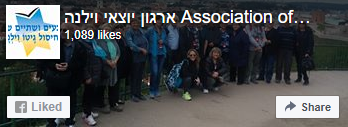Mira Goniondsky
 Mira was born into the Goniondsky family, a well-respected Jewish family in Lithuania. She was educated at the Hebrew Secvondary School in Kovno and, at the same time, was a member of the Betar Youth Movement. Everyone who knew her was impressed by both her beauty and intelligence – so young, rebellious, gifted and beautiful
Mira was born into the Goniondsky family, a well-respected Jewish family in Lithuania. She was educated at the Hebrew Secvondary School in Kovno and, at the same time, was a member of the Betar Youth Movement. Everyone who knew her was impressed by both her beauty and intelligence – so young, rebellious, gifted and beautiful
At the age of 16, she found herself confined with her family in the Vilna Ghetto. Her father, a well-known lawyer, Chairman of Maccabi in Lithuania and with a very rich past in the Lithuanian army, was murdered during the first days of the occupation, moments before his friends in the Lithuanian army could save him
Mira is a mystery and was somehow linked to the ghetto underground (the FPO) while working in the office of the Jewish police. Salek Dessler, who later became the commander of the ghetto police, was blinded not just by her beauty but also by her personality, and so she became his ‘confidant’ . Yosef Glazman, a member of the FPO headquarters, and Betar’s representative there, realized just how essential Mira was to the underground, and asked her to use her skills to pass crucial information to the underground. The information she passed on was of great help to those in the underground after Witenberg, the underground commander, had been extradited, during the Oszmiana Aktion and also during the failed attempt to revolt at the beginning of September, 1943.
History books rarely talk about Mira’s history, and obfuscate about her death. After the underground had decided to move its fighters from the ghetto to the forests, Mira and another young woman were given a note, the contents of which were not revealed to them, and sent to give it to the commander of the Lithuanian partisan brigade in the Naroch forests, about 200 km from the Vilna Ghetto. On a number of occasions, Litman Mor, a member of the ghetto underground, repeatedly told me that the note required the commander of the partisan brigade to eliminate Mira. The person who gave Mira and her friend the note was a member of the FPO, a Jewish communist called Sonia Madiskar. When Mira arrived at the partisan base in Naroch, she was attached to one of the intelligence units as an interpreter since she was proficient in many languages.
History books say that Mira was murdered by the ‘White Poles’ when she was sent by the ‘Lithuanians’ to negotiate with them. Rachel Margolis, another member of the underground, says that Mira had been purposely sent on this mission by the commander of the Lithuanian Brigade, Jurgis (a Jewish communist), so that she wouldn’t return from it.
It is said that he was concerned that Mira was a spy, and that it was apparently difficult for him to accept the fact that Jews served in the Jewish police, which was considered a grave betrayal. Mira’s contact with Dessler was for obtaining crucial information for the underground. Even Abba Kovner, the FPO commander, placed great emphasis on this fact when relating his story to Yehoshua Sobol in the 1980s for the writing of a play about the ghetto. Kovner and his friends from the underground, had previously refrained from mentioning her. It was only when asked for something more piquant about the ghetto for the writing of the play, did Kovner recall Mira, and didn’t stop praising her: “A most unusual personality. Unbelievably trusting …”. Mira was a brave woman, who faithfully did what was asked of her without question or complaint. Kovner adds that Mira had been sent on a mission by Jurgis, knowing full well that she was being sent to her death, but still didn’t question it. She accepted her mission and went to fulfil it … Kovner also doesn’t understand why she was executed and can’t but wonder why they had suspected her – he doesn’t mention whether the FPO was connected in any way to her execution.
Mira didn’t gain as much fame as the other women fighters, such as Rozka Korczak, Vitka Kempner, Tsviya Lubetkin, Haika Grossman and many others. It is really sad that Mira gained a small moment of twisted fame in Yehoshua Sobol’s play ‘Adam’ which was staged at the Cameri Theater in the 1980s. Of course, there is no similarity between the character in the play to Mira Goniondsky, since this is a play and not real life, and the audience doesn’t really know what is reality and what is imagination. The play was closed and Mira remained anonymous.
It remains unknown whether it was the decision of the ghetto underground to eliminate Mira or whether the directive came from the Jew, Jurgis, at the partisan headquarters in Naroch.
Thanks to Miri Yahalom who reveals another fascinated chapter in the resistance activities in the Vilna ghetto: The story of the brave fighter Mira Goniondsky

